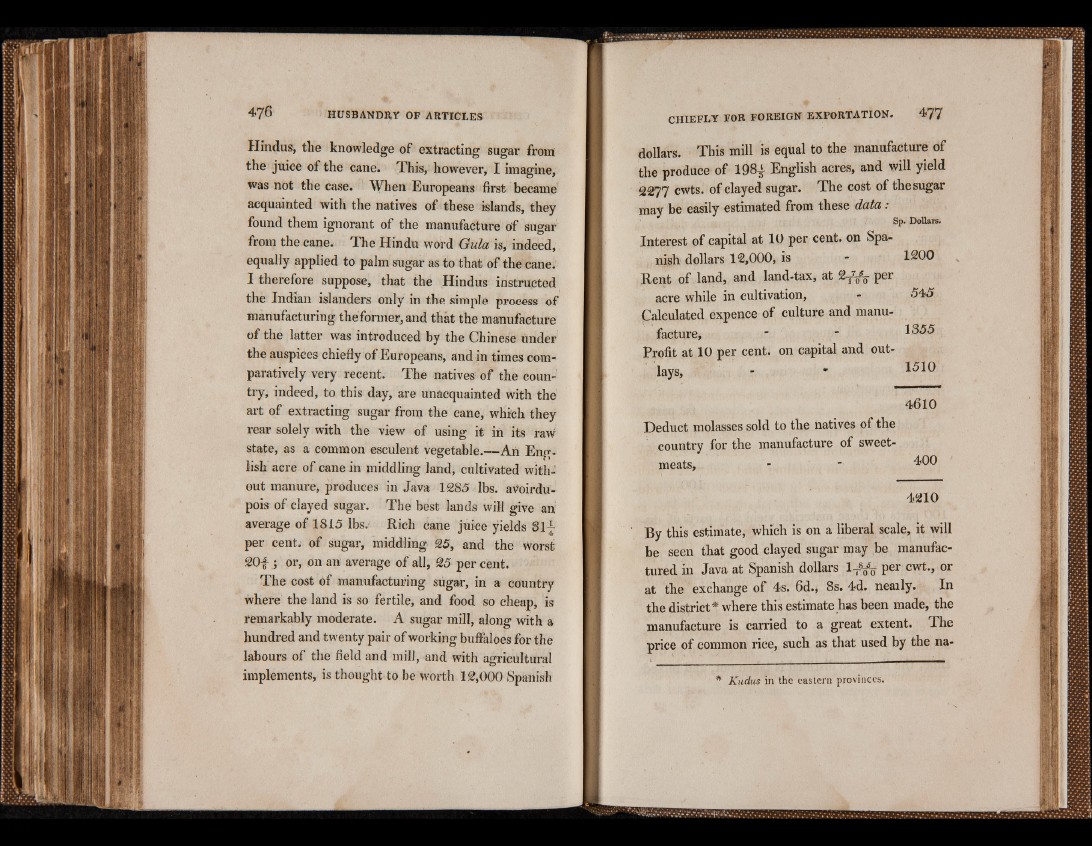
Hindus, the knowledge of extracting sugar from
the juice of the cane. This, however, I imagine,
was not the case. When Europeans first became
acquainted with the natives of these islands, they
found them ignorant of the manufacture of sugar
from the cane. The Hindu word Gula is, indeed,
equally applied to palm sugar as to that of the cane.
I therefore suppose, that the Hindus instructed
the Indian islanders only in the simple process of
manufacturing the former, and that the manufacture
of the latter was introduced by the Chinese under
the auspices chiefly of Europeans, and in times comparatively
very recent. The natives of the country,
indeed, to this day, are unacquainted with the
art of extracting sugar from the cane, which they
rear solely with the view of using it in its raw
state, as a common esculent vegetable.—An Eng-
lish acre of cane in middling land, cultivated without
manure* produces in Java 1285 lbs. avoirdupois
of clayed sugar. The best lands will give an
average of 1815 lbs. Rich cane juice yields 31^
per cent, of sugar, middling 25, and the worst
20£ ; or, on an average of all, 25 per cent.
The cost of manufacturing sugar, in a country
where the land is so fertile, and food so cheap, is
remarkably moderate. A sugar mill, along with a
hundred and twenty pair of working buffaloes for the
labours of the field and mill, and with agricultural
implements, is thought to be worth 12,000 Spanish
dollars. This mill is equal to the manufacture of
the produce of 198| English acres, and will yield
2277 cwts. of clayed sugar. The cost of the sugar
may be easily estimated from these da ta :
Sp. Dollars.
Interest of capital at 10 per cent, on Spanish
dollars 12,000, is - 1200
Rent of land, and land-tax, at 2 - ^ per
acre while in cultivation, - 545
Calculated expence of culture and manufacture,
- " 1355
Profit at 10 per cent, on capital and outlays,
- * 1510
4610
Deduct molasses sold to the natives of the
country for the manufacture of sweetmeats,
- " 400
4210
By this estimate, which is on a liberal scale, it will
be seen that good clayed sugar may be manufactured
in Java at Spanish dollars l TVo Per cwt*> or
at the exchange of 4s. 6d., 8s. 4d. neaily. In
the district* where this estimate has been made, the
manufacture is carried to a great extent. The
price of common rice, such as that used by the na*
Kudus in the eastern provinces.